
10 Sep “Marking an Era: Celebrating Self Help Graphics & Art at 50” at Laguna Art Museum
Through January 15, 2024
By Liz Goldner
Magnificent screen prints, many infused with electric color and Chicano symbolism, are featured in Laguna Art Museum’s Self-Help Graphics exhibition. All 78 prints by 78 artists in the show are owned by the museum.
Looking back, 50 years ago, Franciscan nun Sister Karen Boccalero, along with Mexican-born, local artists Carlos Bueno, Antonio Ibáñez and others, recognized that U.S. born Latinos, especially L.A. based Chicano artists were not being sufficiently recognized by the local and national art worlds. They collaborated with artists and supporters to found Self Help Graphics & Art in a former East L.A. gymnasium in 1973. Their atelier and gallery soon became an important force for nurturing young, Latino artists and friends; and for telling the larger world about their vibrant culture and community.
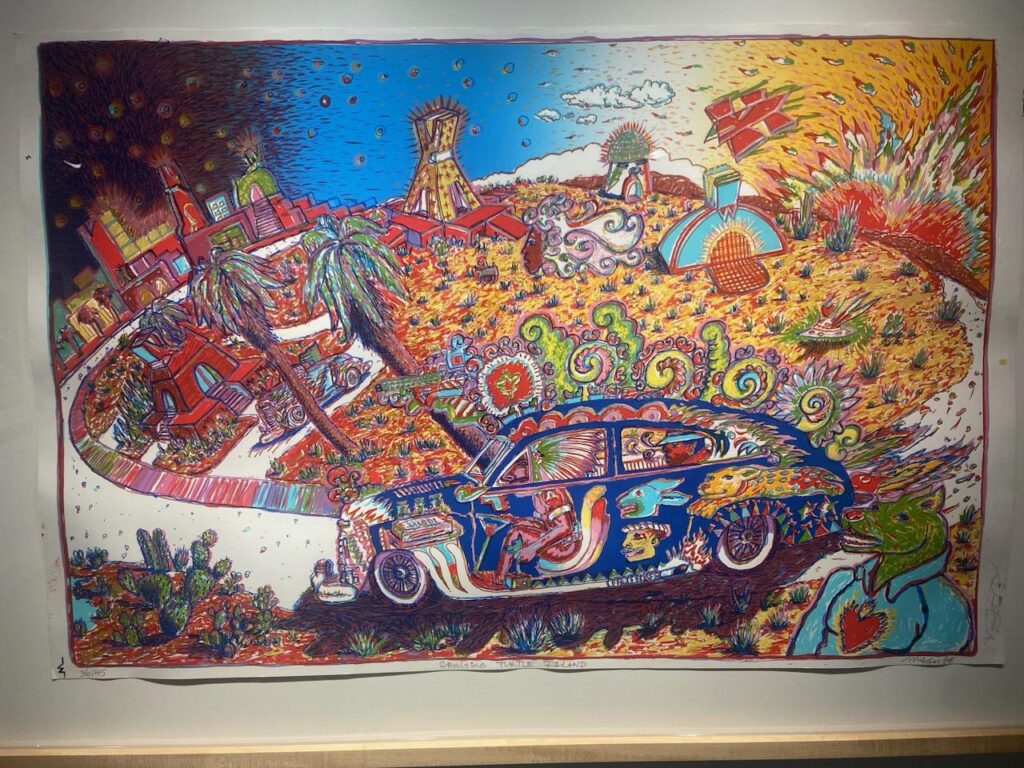
In 1983, Self-Help initiated its advanced Experimental Screen-print Atelier Program, giving artists access to a master printer, materials and silkscreen studio. This gift enabled participating artists to further develop their craft, with many parlaying their professional prints to national and international audiences.
The artists apprenticing at Self Help have explored in their work their Mexican and indigenous ancestry, their struggles for social justice and recognition of their community. All the while, the atelier has created collaborations, partnerships and cultural exchanges, producing prints for collections and institutions nationwide and internationally.
In the exhibition’s first gallery, Gilbert Luján’s “Cruising Turtle Island” (1986) features a wildly painted car, traveling through a tropical, urban landscape, with a dog-person in the lower right corner looking on. This depiction of the artist’s fantasy Magulandia environment (from his nickname, “Magu”) is based on his research into Mesoamerican iconography and architecture.
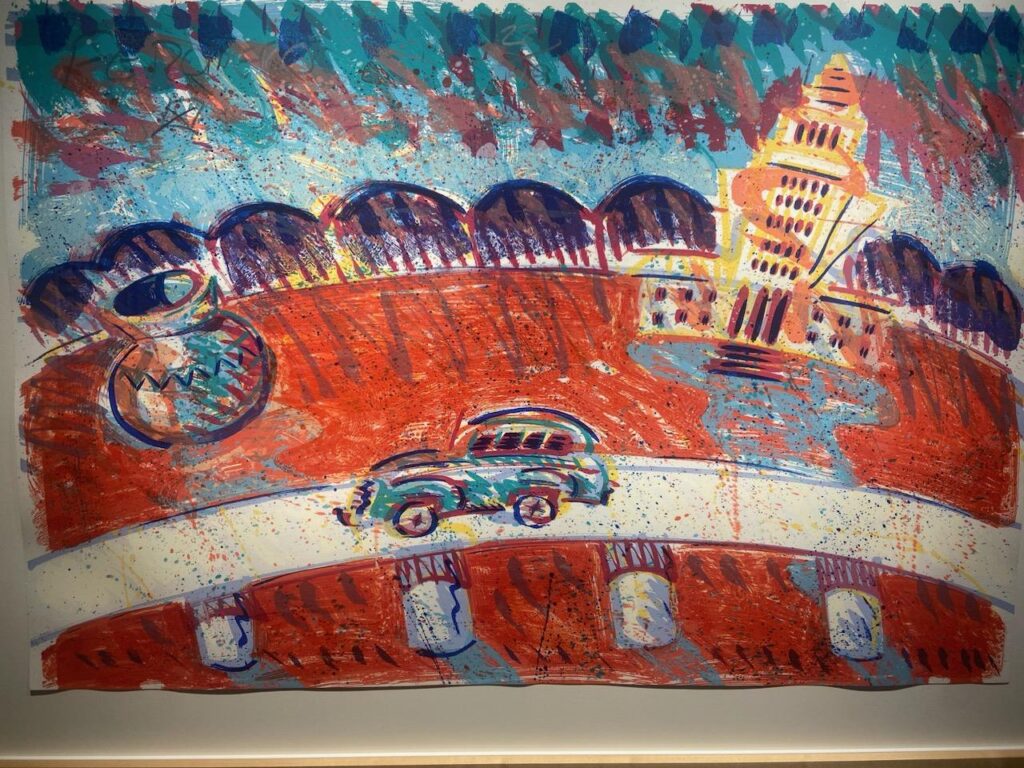
Luján was a dedicated artist and intellectual who helped define and promote Chicano art. In 1969, he wrote: “I believe there is a Chicano Art form and that it has been around for many years without formalization and recognition…Most Chicanos are aware of our current new breed renaissance which has flowered many investigations, probes and introspection in most areas of our life patterns.” He was a co-founder of the Chicano artist collective “Los Four,” which pioneered the presentation of Chicano art, first at UC Irvine in 1973, and at the L.A. County Museum of Art in 1974.
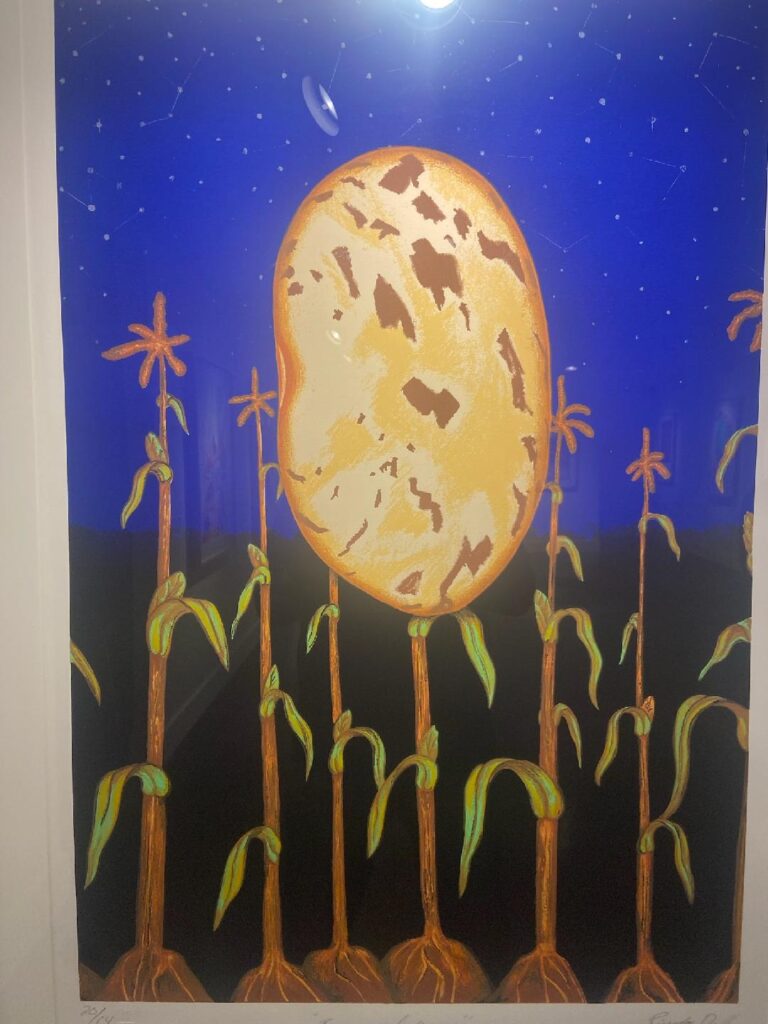
Frank Romero’s “L.A, Landscape” (1986) portrays the sweep of East Los Angeles life and environs in a narrative image. A sedan travels across a freeway, while the surrounding landscape is painted in bright red, a color that the artist often employs. One recognizable local structure is L.A.’s 1930s art deco style City Hall, while a row of buildings, background foliage and pottery are depicted more abstractly.
Romero grew up in the culturally mixed Boyle Heights community of East L.A., became aware of his Latino identity during the Chicano Civil Rights Movement of the 1960s and 70s, and was also a co-founder of “Los Four.” His most important painting is “Death of Rubén Salazar” (1986), a large oil commemorating the L.A Times journalist who chronicled the Chicano Civil Rights Movement, until he was killed by a police tear-gas projectile at the Silver Dollar Café in East L.A. in 1970. The painting is at the Smithsonian American Art Museum.
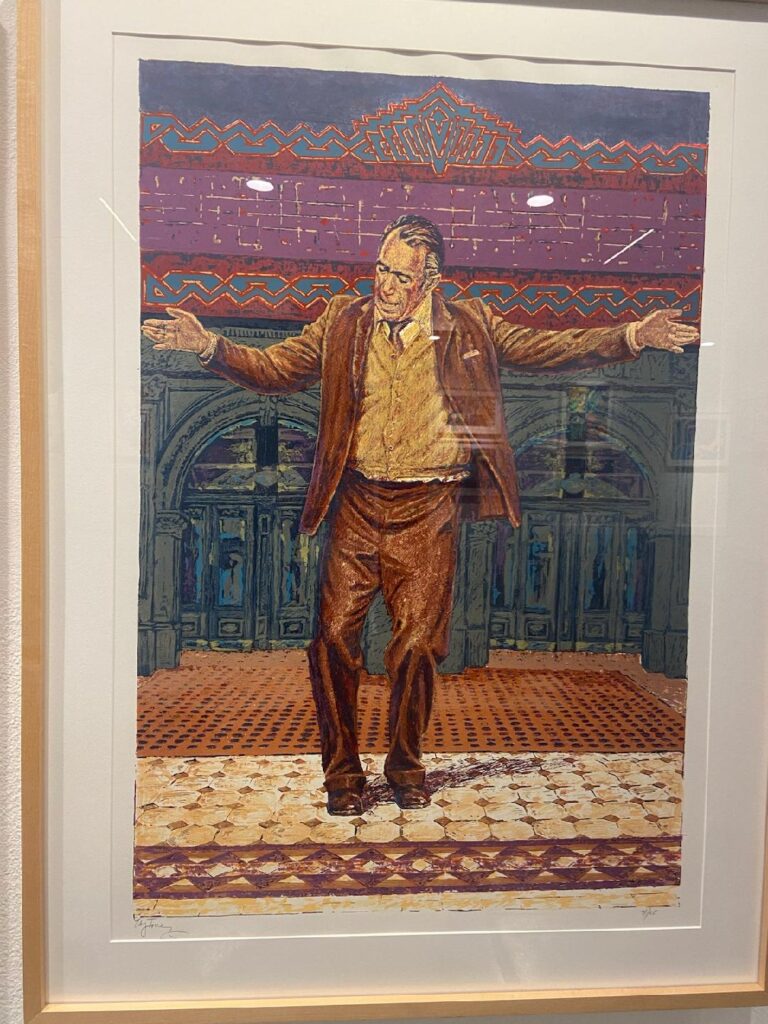
Ricardo Duffy’s serigraph “Beaning Indigenous” (1991) has a play on words title, mimicking the phrase, “Being Indigenous,” which he is in part. Yet his depiction of a large pinto bean against a deep blue sky has a deeper meaning; as in a collection of thousands of beans, each one is entirely unique, just as each person is different from everyone else, he explains.
Duffy grew up in L.A.’s San Gabriel Valley, has indigenous, Mexican, Irish and Lithuanian Jewish ancestry, and infuses his work with social and political perspectives, particularly as they relate to people of indigenous and Mexican ancestry. He created at Self Help the print “The New Order,” conveying Manifest Destiny through its “Marlboro” sign. With a detailed Western landscape backdrop, the print contains a chalky faced George Washington, with a cigarette dangling from his mouth, indicating his collusion with the Marlboro corporate vision. The print is owned by and has been exhibited at the L.A. County Museum of Art.
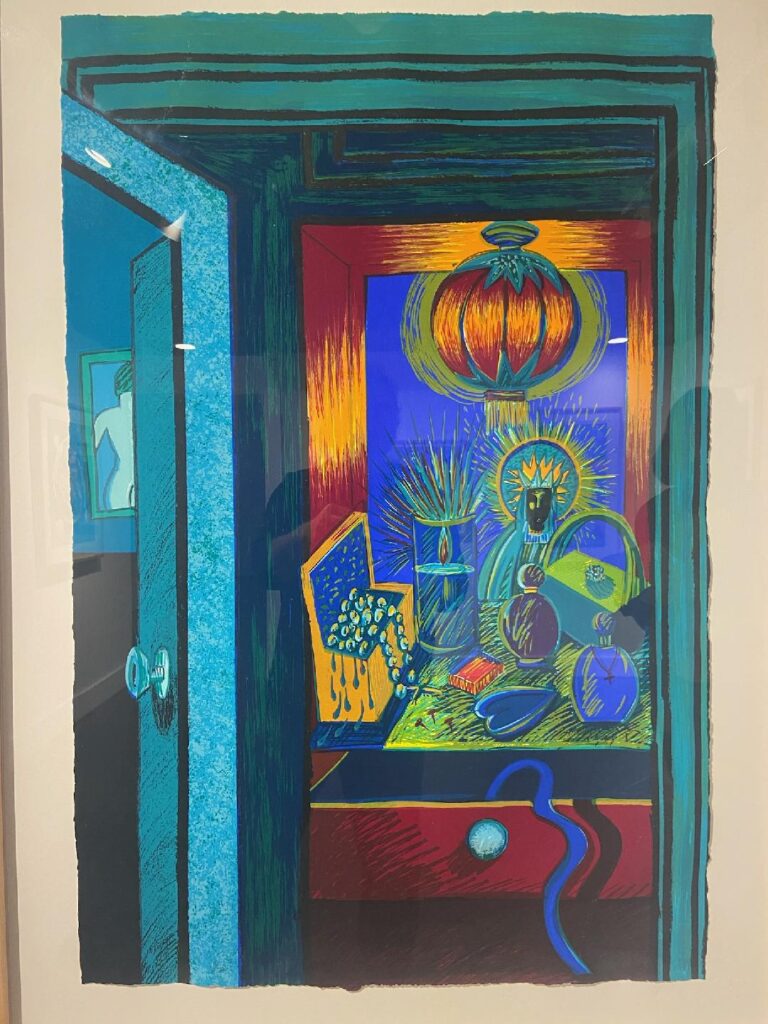
Sister Karen’s 1983 print “Without” in the show is an artistic depiction of the “Seven Deadly Sins” words of Mahatma Gandhi. The words “Science Without Humanity” and “Religion Without Sacrifice” are included, with the latter being one of the nun’s guiding life principles.
In Eloy Torrez’ celebratory “The Pope of Broadway” (1984), actor Anthony Quinn, a native of Mexico, demonstrates a “Zorba the Greek” style dance, Quinn’s signature role. Patssi Valdez’s “The Dressing Table” (1988) contains a riot of accessories, including jewelry, perfume bottles and a black faced figure, printed mostly in neon blues and oranges. Ricardo Gonsalves’ “Don Juan’s Got the Blues” (1988) illustrates an electrified blue coyote in a desert setting, attacking its prey, while surrounded by cacti and purple mountains that echo the shape of the animal. “Hero” (1991) by José Lozano features a close-up of a large, haunting black mask with Mayan inspired designs.
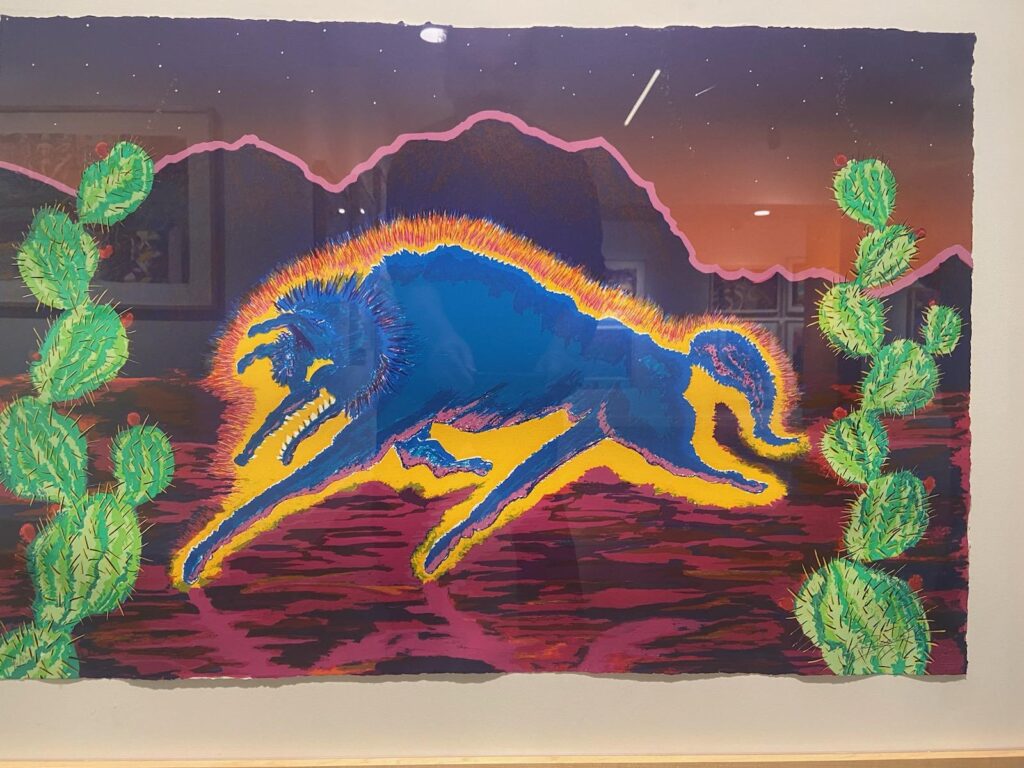
Also of note are screen-prints by Glenna Avila, Yreina Cervántez, Sam Coronado, Alfredo de Batuc, Raoul de La Sota, Richard Durado, Diane Gamboa, Delilah Montoya, Malaquías Montoya, Tony Ortega and Miguel Angel Reyes, among many others, all displaying the varying faces, themes and attitudes of Chicano art.
“It has been an incredible opportunity to see these remarkable prints, consider the political undercurrents that informed them and engage with artists, curators and scholars who continue to push forward this innovative art-making that demonstrates political relevance and community engagement today,” said Rochelle Steiner, guest curator for the exhibition.




Sorry, the comment form is closed at this time.